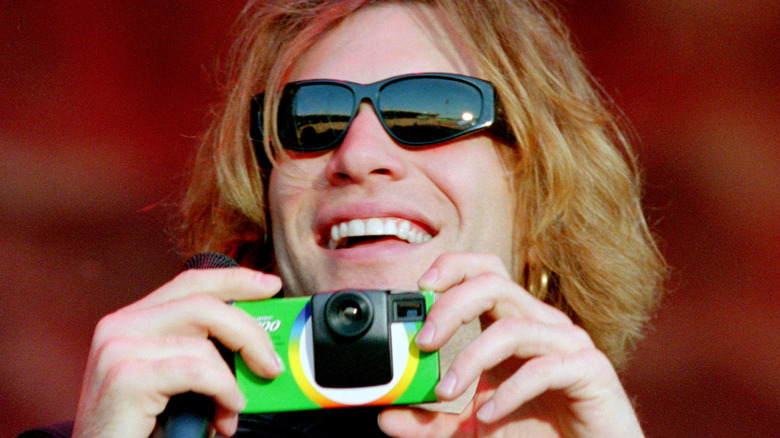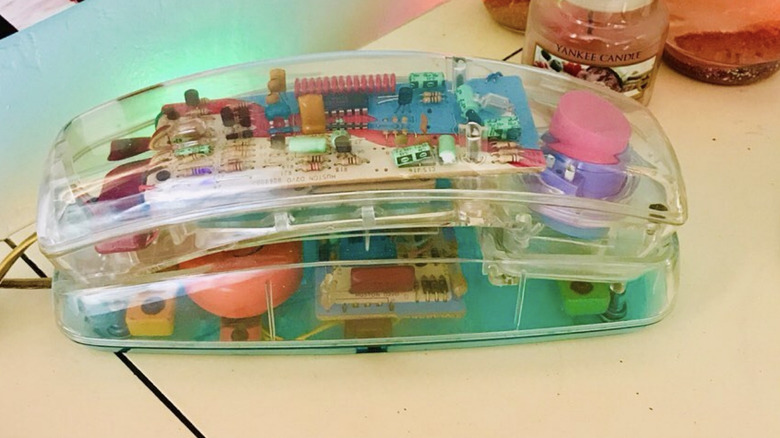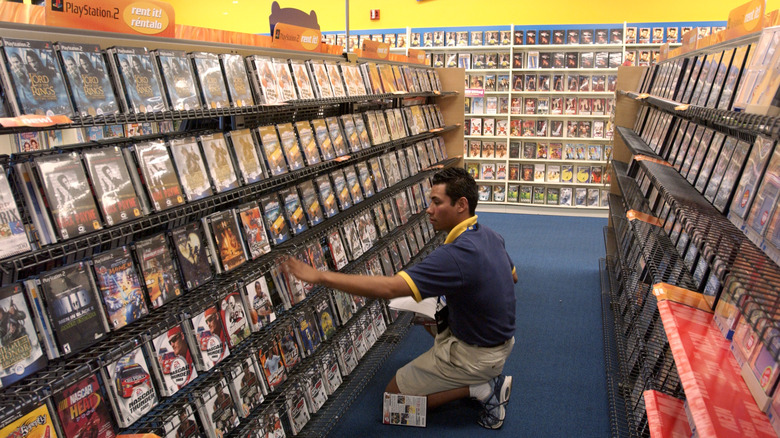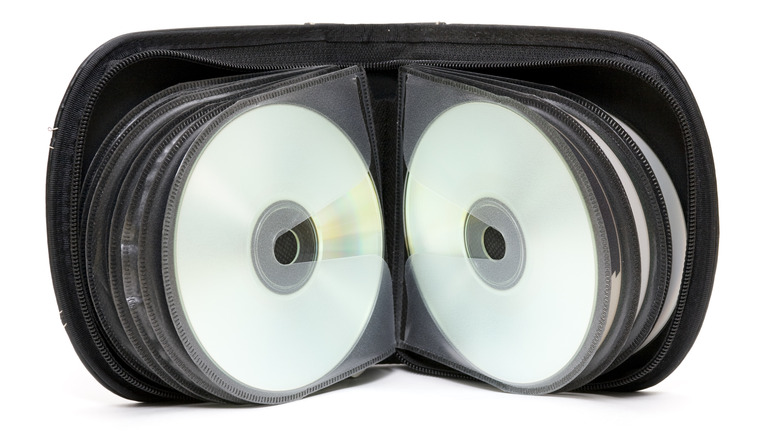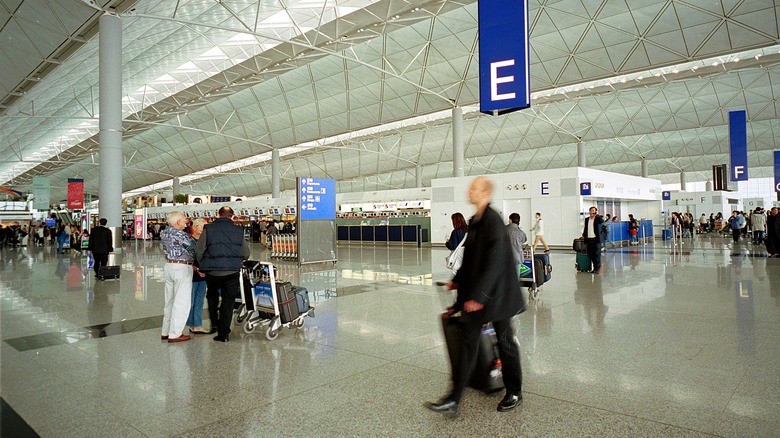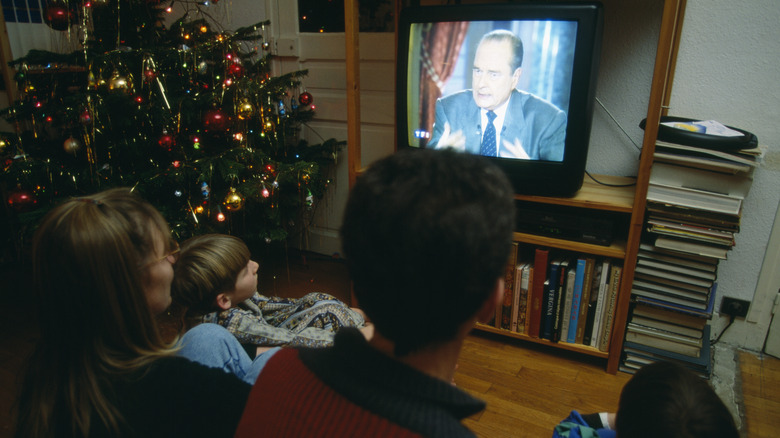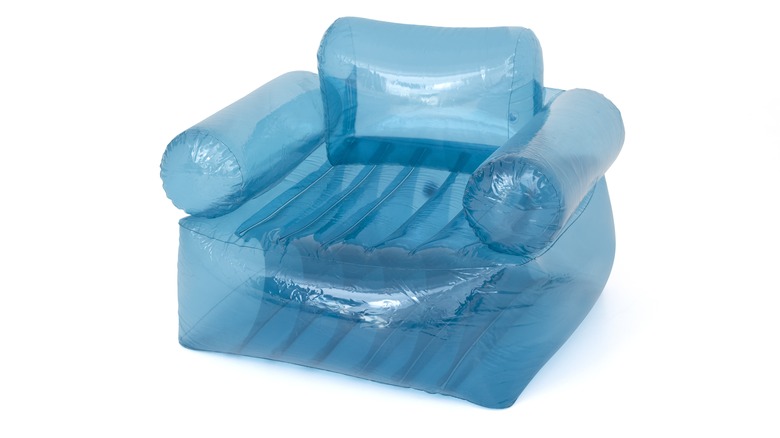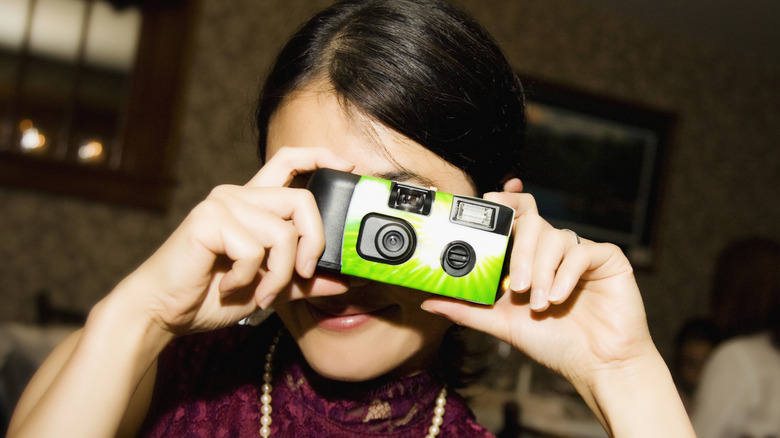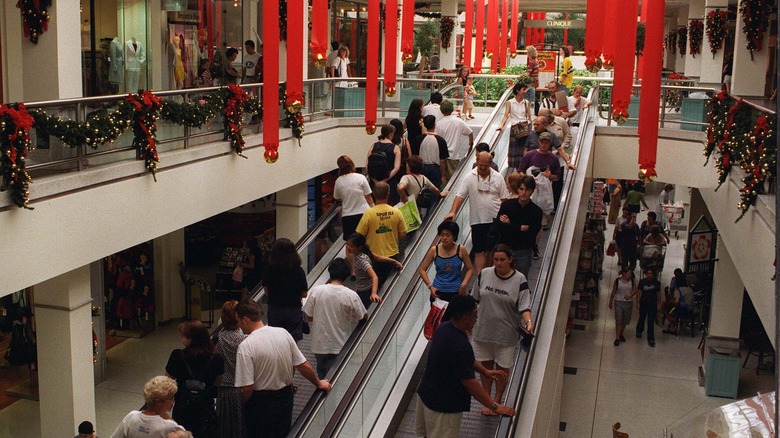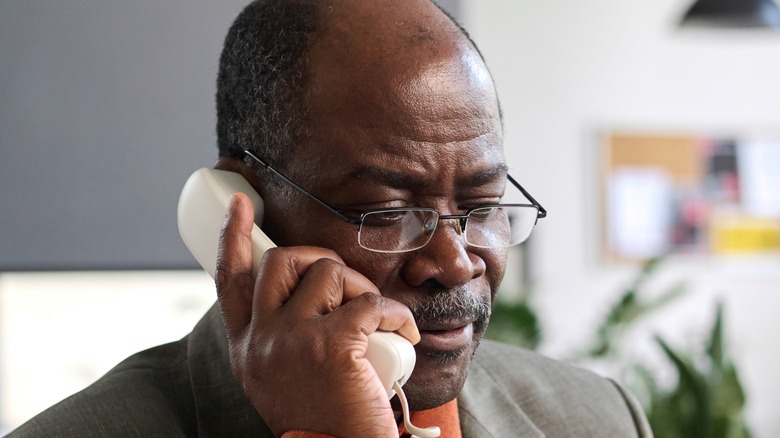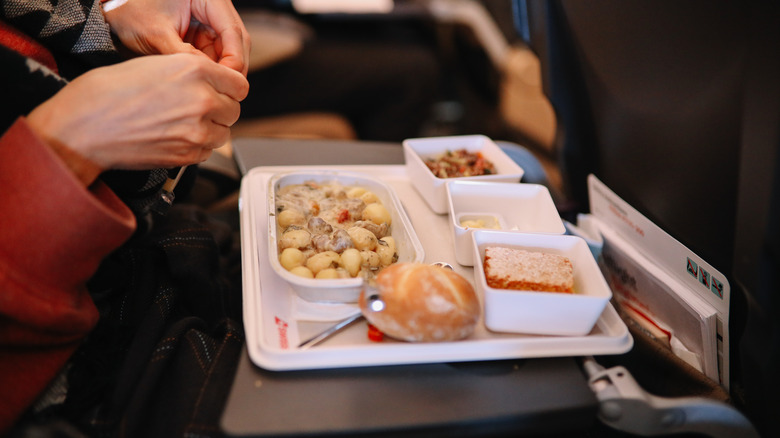Things People Did In The '90s That Seem Absolutely Bizarre Today
We may receive a commission on purchases made from links.
Never mind the big changes in pop culture or the world at large — life is mostly about how we fill time in the day-to-day. Everybody interacts with one another and the structures of the world, and it's a life to which they become accustomed. And then, due to changing trends or the advent of new technology, so much of what we take for granted disappears. This is especially and collectively true for the 1990s, a time when big and brash was in fashion. The music, movies, and TV were good, and much of it came with a sense of convenience and luxury.
But then, as the calendar flipped over and the '90s became the 2000s, almost everything changed. Common activities, habits, hobbies, and daily tasks grew distant and obsolete with the arrival of new technology and regulations. So many very '90s things have disappeared to the extent that if one attempted to enjoy them or do them today, they might get some odd looks. Here are all the mundane, if nostalgically remembered, aspects of life in the '90s that just don't really exist the same way as in the 2020s and beyond.
Using a landline telephone and all of its accessories
By the 1990s, the telephone was a century-old technology and a regular part of life so entrenched as to be taken for granted, but also a place where emerging communications technology ran rampant. It was also the last era before the common setup of one household sharing one landline became one of many things killed by the smartphone. As a result, certain behaviors that were commonplace may seem baffling, invasive, and annoying from a 2020s perspective. In an age where individuals all have their own smartphone, it's odd to look back at a time when one couldn't simply directly text or call a friend — they'd have to pick up a phone, call the other person's house, and if someone than the targeted party picked up, they'd have to engage in small talk with them for a moment.
Today, all smartphone activity is covered under contracted plans, with extra charges coming only for exceeding monthly limits. However, in the 1990s, collect calls were still a major and expensive way to connect. Heavily advertised discount collect calling services proliferated in the decade; users would dial a prefix like 10-10-220 or 10-10-321 before a call to get the other side to pay for it. And in terms of delayed communication, virtual voicemail systems began to replace tape-based answering machines in the 1990s, while dialing *69 predated universal caller ID on smartphones by allowing phone customers to find out the number of the party who had just called them.
Renting movies and video games
From the late '80s until well into the 2000s, and peaking in culture and practice in the 1990s, millions of families could make any night a Blockbuster night. A ritual specific to the VHS and early DVD eras, groups would traipse to one of thousands of Blockbuster Video outlets or to a competing chain or even an independently owned store, and wander through the aisles until a movie could be found that everyone could agree on. There were often high stakes, as one had to arrive early on Friday and Saturday nights to grab a highly-coveted selection from the "New Releases" wall. Those who didn't necessarily want to watch a movie could rent a video game.
The slow, gradual death of physical media spelled the end of days for the stores who rented out video tapes, DVDs, or cartridge-based games. The sudden rise and fall of Blockbuster can be blamed in large part on Netflix offering at first DVD rental by mail — without the chain's high late-return fees — and then via "streaming," delivered over high-speed internet lines. Blockbuster went bankrupt in 2010, and what was once an overall nationwide market of 28,000 video stores in 2000 is down to less than 700 in 2024, so even if you wanted to today, the options for renting movies or games are slim.
Buying, collecting, and storing CDs
Introduced in 1982 with ABBA's "The Visitors," the thin, digital compact disc was accepted as a technological marvel upon its arrival. Offering convenience and crisp, high-quality audio, CDs finally overtook vinyl records and cassette tapes as the top-selling musical format in the United States in 1991. Americans bought hundreds of millions of CDs every year in the '90s; blockbuster releases routinely sold a million copies or more in their first week of availability.
Before the arrival of paid digital music downloads and smartphone-centered streaming services in the 2000s, taking one's music collection with them required the purchase of additional equipment or accessories. Car CD players or personal CD players, like Sony's Discman, could be loaded up at will with discs slipped out of a bursting CD wallet. More expensive options like CD changers were available, allowing users to put six or so CDs in a stereo's removable carousel for a much larger selection of instantly accessible music.
The spread of piracy-based digital music sites like Napster in the late '90s and early 2000s slowly killed off the CD, as did Apple. The computer company broke through with its iPod, a pocket-sized device that held thousands of digitally stored songs, making the CD — and storing CDs — virtually obsolete. In 2022, only 33 million CDs were sold, and busting out a CD in today's phone-loving world would be seen as a personality quirk or something only audiophiles do.
Hanging out at airplane gates
Should one try to walk right into an airport and head to the gates to meet up with or reunite with a newly arrived loved one, they probably wouldn't get very far. There are security officers and TSA checkpoints in place to prevent such a thing from happening, and an arrest or expulsion from the airport are the most likely outcomes for anyone trying. At American airports, one has to be in possession of a ticket and boarding pass to enter the inner sanctum.
Up until 2001, flying was a much more relaxed affair. Those trying to make flights maybe had to walk through a simple metal detector and then approach their departure gate. Anyone greeting arriving passengers or seeing off departing ones could walk almost all the way to the planes, too, so long as they also passed through the metal detector. The very quick elimination of this practice is one of the many messed up things that happened after the Sept. 11 attacks. The Transportation Security Authority was tasked with newly instituted, federal government-mandated laws to prevent future tragic terrorist attacks from happening. One measure barred non-passengers from entering all but the most tertiary parts of American airports.
Watching live television
By 1990, the majority of American homes were equipped with a VCR, but the heavy usage and real money in that appliance came from the rental of pre-recorded movies from a local or chain store. It was a bit more difficult to set up the device to use the "R" in VCR and record a live television broadcast for viewing at a later time. Cable TV didn't yet offer a plethora of high-quality narrative content, and envelope-pushing streaming services didn't even exist, so in the 1990s most people who wanted to watch TV watched whatever the networks chose to schedule, and they watched it exactly when it was on.
Some of the most popular and well-promoted shows became cultural touchstones. NBC's "Must See TV" branded Thursday-night lineup included era-definitive content like "Friends," "Seinfeld," and "ER," and people would discuss major happenings the next day at work — this phenomenon was nicknamed "water cooler television."
By the 2020s, one could become a pariah by discussing a popular TV show or divulging "spoilers" around others who hadn't gotten around to watching it yet. Delayed viewing – with TiVO and other digital video recorders that store TV programming, and then with the advent of streaming services — means that fans can watch a show whenever they want, and not just during the time slot when it happens to first air. Subsequently, live TV viewing has cratered since the early 1990s because technology provides so many more alternatives.
Buying and using inflatable furniture
By their very nature, trends and fads don't stick around. Some object or activity captures the collective curiosity or fancy, millions adopt it, and then as soon as the novelty wears off, it's embarrassingly passé and disappears from the world just as quickly as it arrived. To stick to a fad, particularly one in home furnishings, for decades after its brief moment of glory, would be viewed as strange. For example, if one were to furnish their well-past-the-'90s dorm room, apartment, or house with inflatable furniture, it would garner some raised eyebrows and a lot of questions.
Invariably inexpensive and brightly colored — which might explain the attraction — what looked like inner tubes or air mattresses in the form of armchairs, couches, love seats, and ottomans filled homes. What made inflatable furniture join the pantheon of popular things from the 1990s you don't see anymore? They weren't built for the long haul, nor were they very comfortable or stable.
Taking photos with a film camera
Today's smartphones are outfitted with sophisticated cameras and advanced photo editing tools, and since about 90% of American adults regularly use such a device, this means almost everyone these days is a photographer. What was once considered the provenance of specialized professionals or dedicated hobbyists is now something virtually anyone can do with some level of acuity. This revolution in photography began with the advent of consumer-level digital cameras in the late 1990s, which eliminated many of the most annoying and expensive elements of taking pictures. Whether a self-styled photographer used an expensive film-requiring Canon EOS Rebel 35 millimeter camera or a cheap disposable model with the film built-in, it cost an additional amount of money to get that film developed and printed into physical photographs. Other than relying on one's own photography skills and talents, there was little way to know if the photos would be any good until after they came back from the photo lab. Digital cameras and smartphones let picture-takers see right away if their photos are keepers, and if they maybe need to take another stab at it.
Film cameras and disposable cameras, like the Kodak FunSaver and Fujifilm QuickSnap, are still available for purchase, but at a higher premium than they once were, and with far fewer places to get the film developed than there were 30 years ago.
Going to the mall
Americans today are just like their counterparts in the 1990s in needing to buy clothing, accessories, home furnishings, and gifts. The big difference between then and now is where they get them. In the contemporary U.S., shopping is more of a direct task and less a form of immersive entertainment, with required goods purchased at Target or Walmart or online retailers like Amazon. The old way of doing things — purchasing a wide variety of items, or maybe none at all, at a shopping mall — is a dying pastime.
Not only were malls of the '90s full of nationally renowned anchor department stores and smaller shops selling an array of merchandise, but they were entertainment destinations, too. Shopping centers also housed movie theater multiplexes, arcades, and other draws, all not far from a well-stocked fast-food-based food court. Such lures made malls a major place for young people to hang out, not least because it was a relatively safe space to congregate. Asking a group of friends in the present day if they want to go to the mall and just hang out is a rarity. Malls are disappearing and the ones that do remain open are sparsely occupied, partly because they're just not as hospitable or exciting anymore.
Calling hotlines and toll-free information numbers
In the 1990s, various media outlets and pundits predicted the rise of an "information superhighway," in which all human knowledge, including current and breaking news and data, would be available instantly through a globally interconnected computer network. That all came true, manifested as the internet, and with the additional development and near-universal adoption of smartphones, finding the exact information one needs only takes a few touch-screen maneuvers over the course of a few seconds. But before then, in the age before telephones were smart and when they were reliant on physical lines, it used to be moderately harder to find basic, even mundane, information or to distantly participate in a live conversation.
The internet made telephone-based voice information services seem clunky, and they're effectively obsolete today. Before MTV's "TRL" disappeared, viewers could dial a number and vote for their favorite video to be played on a countdown. Calling "777-FILM" (plus an area code) unlocked a recorded playback of local film showtimes via Moviefone, a service popular in the 1990s but which shut down in 2014. Newspapers and other media companies operated hotlines full of push-button-triggered information, while other single-use services welcomed brisk business by delivering extremely accurate time and weather forecasts. Many of those hotlines are still around, but they only attract a fraction of the customers they once did.
Enjoying an in-flight meal
From the early days of commercial air travel in the 1950s and 1960s, an in-flight meal was a treat and just one part of the then-glamorous airplane trip. Customers in all travel classes, even lower-cost coach, could expect to receive meal service during even a domestic flight of just a few hours in duration. It would consist of multiple courses or several items, and even through the '90s, it was just a part of flying. It may not have been the best-tasting food, but it was a nice amenity that didn't cost extra.
In 1978, the Airline Deregulation Act let airlines create their own pricing system, and so they started to scale back on what were considered extras and charge more for those things that used to be included in the price of a flight ticket. To eke out more profit, complimentary meal service was eliminated virtually industry-wide. First-class and business-class passengers might get chef-curated or specially-prepared meals, and pay for it now, but customers in coach are offered prepackaged sandwiches or snack boxes at elevated rates. In-flight meal service included in the price virtually disappeared in the 21st century.
Doing math the old-fashioned way
Despite how millions must have felt toiling away on what seemed to be useless and arbitrary algebra and trigonometry problems in high school, the real world of adulthood did wind up involving a lot of math after all. Whether calculating a tip, measuring something, working out a personal or workplace budget, managing time, or as a part of many other mundane daily tasks, math is a vital and necessary tool for daily existence.
Many everyday equations and number-crunching can be done in one's head, or, as was the way it was historically conducted, with a pencil or pen and a piece of scrap paper. The invention of the first handheld calculator in the 1970s made the act of doing basic math in school or elsewhere simple and fast, with very little brain power required. But to anticipate the need for daily math and carry around a calculator on one's person in the 2020s would be absurd and redundant: Almost everyone has a smartphone in their pocket already taking up space, and those all come standard with a calculator app. The convenience of the smartphone has pretty much supplanted the need for calculators and even mental math.
